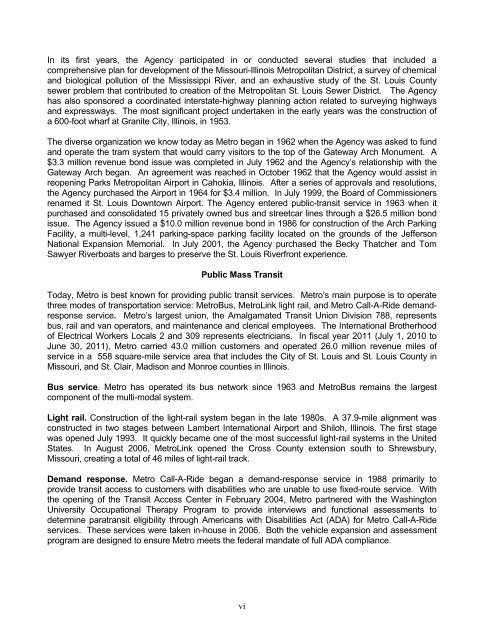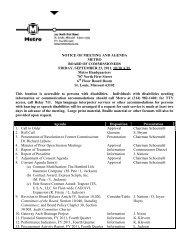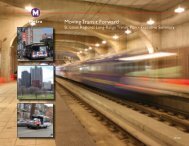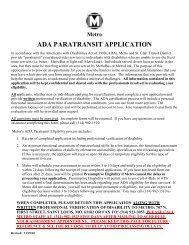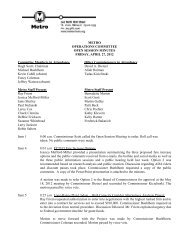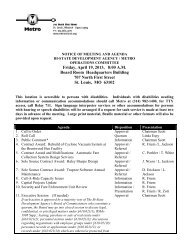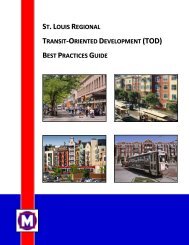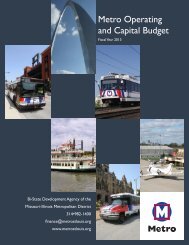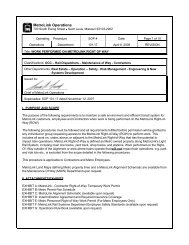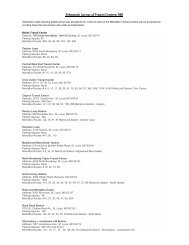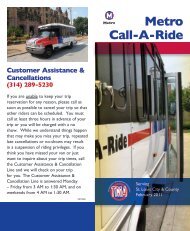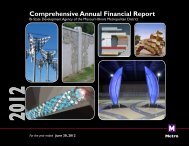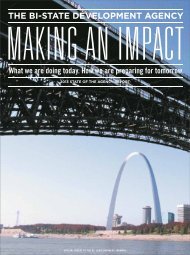Comprehensive Annual Financial Report - Metro Transit
Comprehensive Annual Financial Report - Metro Transit
Comprehensive Annual Financial Report - Metro Transit
You also want an ePaper? Increase the reach of your titles
YUMPU automatically turns print PDFs into web optimized ePapers that Google loves.
In its first years, the Agency participated in or conducted several studies that included acomprehensive plan for development of the Missouri-Illinois <strong>Metro</strong>politan District, a survey of chemicaland biological pollution of the Mississippi River, and an exhaustive study of the St. Louis Countysewer problem that contributed to creation of the <strong>Metro</strong>politan St. Louis Sewer District. The Agencyhas also sponsored a coordinated interstate-highway planning action related to surveying highwaysand expressways. The most significant project undertaken in the early years was the construction ofa 600-foot wharf at Granite City, Illinois, in 1953.The diverse organization we know today as <strong>Metro</strong> began in 1962 when the Agency was asked to fundand operate the tram system that would carry visitors to the top of the Gateway Arch Monument. A$3.3 million revenue bond issue was completed in July 1962 and the Agency’s relationship with theGateway Arch began. An agreement was reached in October 1962 that the Agency would assist inreopening Parks <strong>Metro</strong>politan Airport in Cahokia, Illinois. After a series of approvals and resolutions,the Agency purchased the Airport in 1964 for $3.4 million. In July 1999, the Board of Commissionersrenamed it St. Louis Downtown Airport. The Agency entered public-transit service in 1963 when itpurchased and consolidated 15 privately owned bus and streetcar lines through a $26.5 million bondissue. The Agency issued a $10.0 million revenue bond in 1986 for construction of the Arch ParkingFacility, a multi-level, 1,241 parking-space parking facility located on the grounds of the JeffersonNational Expansion Memorial. In July 2001, the Agency purchased the Becky Thatcher and TomSawyer Riverboats and barges to preserve the St. Louis Riverfront experience.Public Mass <strong>Transit</strong>Today, <strong>Metro</strong> is best known for providing public transit services. <strong>Metro</strong>’s main purpose is to operatethree modes of transportation service: <strong>Metro</strong>Bus, <strong>Metro</strong>Link light rail, and <strong>Metro</strong> Call-A-Ride demandresponseservice. <strong>Metro</strong>’s largest union, the Amalgamated <strong>Transit</strong> Union Division 788, representsbus, rail and van operators, and maintenance and clerical employees. The International Brotherhoodof Electrical Workers Locals 2 and 309 represents electricians. In fiscal year 2011 (July 1, 2010 toJune 30, 2011), <strong>Metro</strong> carried 43.0 million customers and operated 26.0 million revenue miles ofservice in a 558 square-mile service area that includes the City of St. Louis and St. Louis County inMissouri, and St. Clair, Madison and Monroe counties in Illinois.Bus service. <strong>Metro</strong> has operated its bus network since 1963 and <strong>Metro</strong>Bus remains the largestcomponent of the multi-modal system.Light rail. Construction of the light-rail system began in the late 1980s. A 37.9-mile alignment wasconstructed in two stages between Lambert International Airport and Shiloh, Illinois. The first stagewas opened July 1993. It quickly became one of the most successful light-rail systems in the UnitedStates. In August 2006, <strong>Metro</strong>Link opened the Cross County extension south to Shrewsbury,Missouri, creating a total of 46 miles of light-rail track.Demand response. <strong>Metro</strong> Call-A-Ride began a demand-response service in 1988 primarily toprovide transit access to customers with disabilities who are unable to use fixed-route service. Withthe opening of the <strong>Transit</strong> Access Center in February 2004, <strong>Metro</strong> partnered with the WashingtonUniversity Occupational Therapy Program to provide interviews and functional assessments todetermine paratransit eligibility through Americans with Disabilities Act (ADA) for <strong>Metro</strong> Call-A-Rideservices. These services were taken in-house in 2006. Both the vehicle expansion and assessmentprogram are designed to ensure <strong>Metro</strong> meets the federal mandate of full ADA compliance.vi


